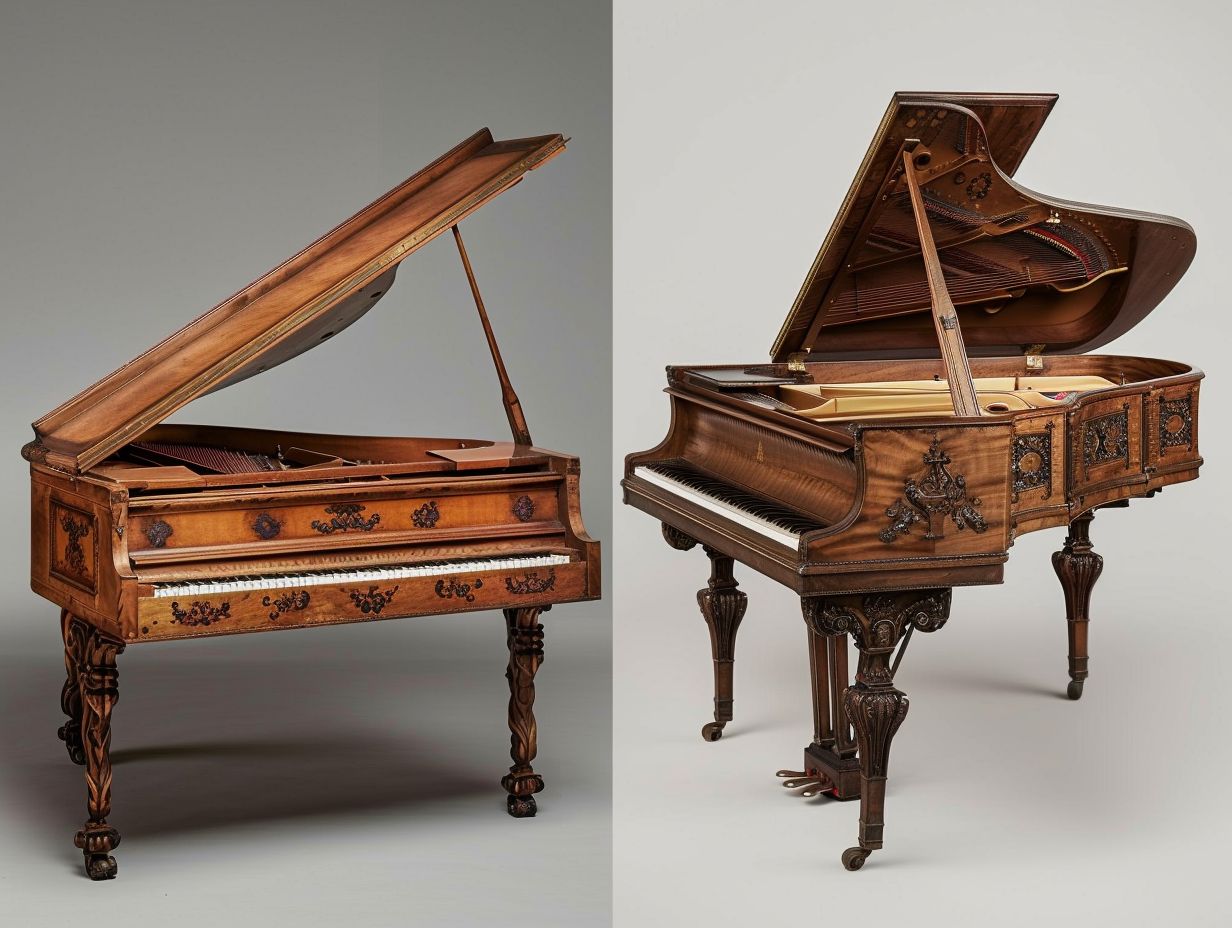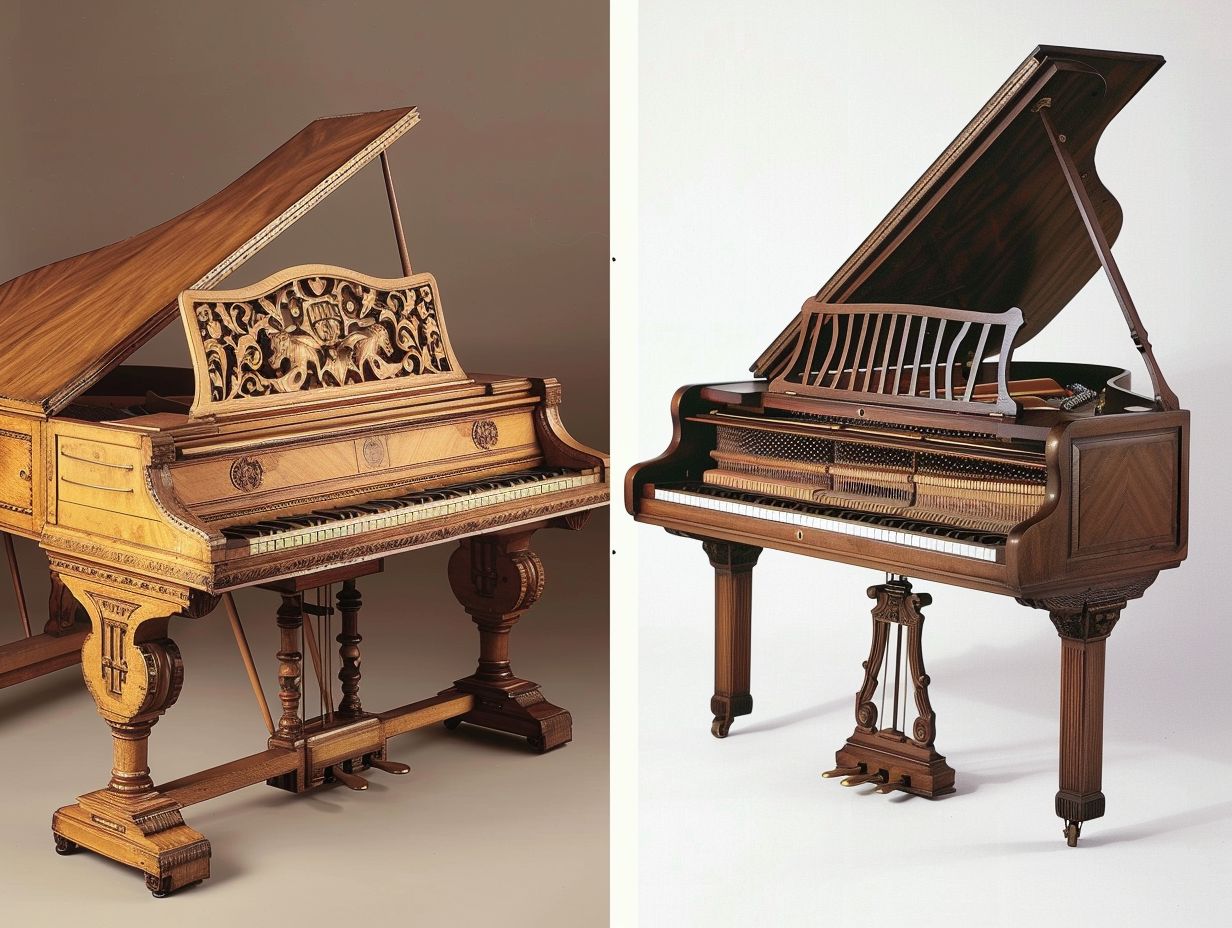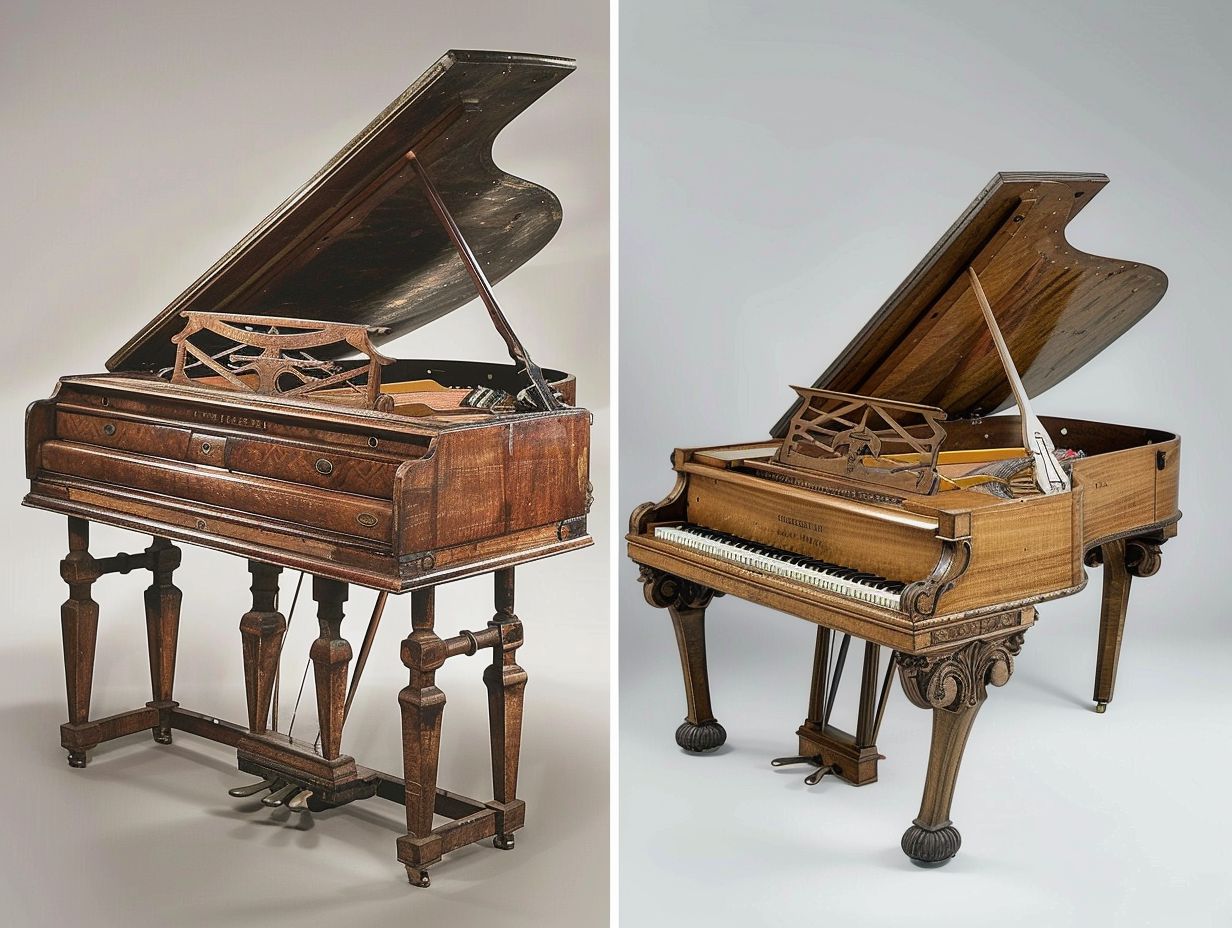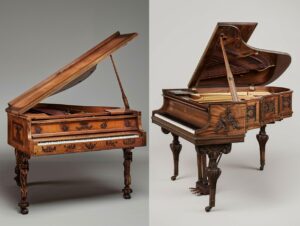Have you ever wondered about the differences between the fortepiano and the modern piano? From their history and evolution to their key characteristics and physical differences, these two instruments have unique qualities that set them apart.
In this article, we will explore the sound and tone variations between the fortepiano and piano, as well as the playing techniques specific to each. We’ll also delve into notable composers and pieces for each instrument, giving you a comprehensive overview of these musical treasures.
| Aspect |
Fortepiano |
Modern Piano |
| History and Origin |
Invented in early 1700s by Bartolomeo Cristofori |
Evolved from fortepiano in the late 1700s |
| Sound and Tone |
Softer, more delicate, mellow sound |
Louder, more forceful, sustained sound |
| Construction |
Thinner strings, lighter frame, simpler mechanism |
Thicker strings, stronger frame, complex mechanism |
| Action Mechanism |
Leather-covered hammers, lighter touch |
Heavier hammers, robust strings |
| Pedals |
Lacks pedals, relies on touch sensitivity |
Features pedals for sustain and resonance control |
| Size and Shape |
Compact and ornate designs |
Larger and more standardized structures |
| Playing Techniques |
Requires delicate touch, subtle dynamics |
Requires broad touch sensitivity, dynamic control |
| Soundboard |
Smaller soundboard, focused tonal quality |
Larger soundboard, rich and deep tonal quality |
| String Length |
Shorter strings |
Longer strings |
| Notable Composers |
Mozart, Beethoven (early works) |
Beethoven (later works), Chopin, Liszt |
| Common Compositions |
Sonata in C Major, K. 545 by Mozart |
Piano Sonata No. 29, Op. 106 by Beethoven |
| Playing Style |
Emphasis on intimate, expressive playing |
Capable of powerful, dramatic performances |
| Physical Characteristics |
Smaller, lighter, intricate embellishments |
Larger, heavier, robust construction |
| Usage |
Classical and early Romantic music |
Classical, Romantic, contemporary music |
| Cultural Influence |
Reflects Vienna’s elegance and refinement |
Adapted to the demands of the Industrial Revolution |
| Maintenance |
Less complex, requires delicate care |
More complex, requires regular professional maintenance |
| Popularity |
Used primarily for historical performance practice |
Widely used in modern performances and recordings |
History and Evolution of the Instruments

The historical progression and development of keyboard instruments, including the fortepiano and modern piano, are imbued with substantial innovation and musical advancement. The inception of the piano can be traced back to Bartolomeo Cristofori’s creation of the earliest known piano in the early 18th century, during a period when harpsichords reigned as the principal keyboard instrument.
Cristofori’s groundbreaking design introduced dynamic control by utilizing hammers to strike the strings, thereby laying the groundwork for the evolution of the contemporary piano. Subsequently, influential figures such as Sebastien Erard, John Broadwood, and Heinrich Stein embarked on further enhancements to the instrument’s construction. Their contributions encompassed the integration of advancements like the double escapement mechanism, alongside improvements in sound quality and touch sensitivity. Noteworthy composers like Mozart and Beethoven also made substantial contributions to the piano’s evolution by expanding its capabilities, thus influencing its design and performance in significant manners.
Differences in Sound and Tone
The fortepiano and modern piano display notable distinctions in sound and tone attributed to their unique mechanisms and construction.
The fortepiano employs a hammer mechanism where leather-covered hammers strike the strings, resulting in a mellower and more intimate sound that is particularly well-suited for classical music compositions from the Classical and early Romantic eras. Conversely, the modern piano incorporates heavier hammers and more robust strings, producing a more forceful and sustained sound that is adaptable to a broad spectrum of musical genres.
In terms of functionality, the fortepiano lacks pedals, requiring the player to rely on touch sensitivity to control dynamics. On the other hand, the modern piano features a range of pedals that govern sustain and resonance, thereby influencing the overall production of tone.
Key Characteristics of Fortepiano
The invention of the fortepiano, attributed to Bartolomeo Cristofori, embodies key characteristics that were integral to the early design and functionality of the instrument. Its groundbreaking keyboard mechanism, utilizing hammers to strike the strings, facilitated dynamic touch sensitivity. This innovation allowed renowned musicians such as Mozart and Beethoven to delve into new realms of musical expression.
The fortepiano’s design offered a broader range of tonal capabilities compared to its predecessor, the harpsichord. This enhanced versatility in sound production was further augmented by the instrument’s capacity to generate both soft, intimate tones and robust, resonant sounds through varying degrees of pressure on the keys. These distinctive features positioned the fortepiano as an essential instrument for composers aiming to convey a diverse array of emotions through their musical compositions, thereby influencing the evolution of classical music during the 18th and 19th centuries.
Key Characteristics of Piano
The modern piano, an evolved iteration of the fortepiano, exhibits distinct characteristics that have influenced its progression and enduring popularity among keyboard instruments. Through advancements in pedal mechanisms, keyboard construction, and tone production, pianos crafted by renowned makers such as Backers, Erard, and Broadwood offered refined touch control and a resonant, full-bodied tone that found favor among eminent composers like Mozart and Beethoven.
Throughout the course of history, these esteemed piano manufacturers introduced pioneering features including enhanced sustaining pedals, facilitating prolonged resonances and nuanced expressiveness during performances. The integration of escapement mechanisms in keyboard actions heightened the instrument’s touch sensitivity, give the power toing musicians to attain superior control and dynamics. Innovations in string materials and frame construction by notable manufacturers notably elevated the tonal quality, delivering a more vibrant and melodious sound. Collaborative efforts between skilled craftsmen and distinguished composers further honed the design and functionality of the modern piano, cementing its position as an essential element in both classical and contemporary music.
Physical Differences between Fortepiano and Piano

The distinctions between the fortepiano and modern piano encompass various physical attributes, including size, shape, and construction, which signify the evolution of keyboard instruments throughout history. The fortepianos favored in Vienna were characterized by compact and ornate designs, reflecting the city’s focus on elegance and refinement in music.
On the other hand, the pianos developed in England and Paris featured more robust and standardized structures to meet the demand for durability and power in performances, influenced by the advancements of the Industrial Revolution in instrument manufacturing.
Vienna’s fortepianos, known for their smaller dimensions and intricate embellishments, were emblematic of the city’s cultural emphasis on sophistication and aesthetic appeal in musical instruments. In contrast, the sturdier frames of English pianos catered to the evolving requirements for resilience and projection during musical performances, showcasing the impact of industrial advancements on the instrument’s construction. The Parisian pianos, characterized by sleek profiles and luxurious finishes, captured the essence of Romanticism prevalent during the era of composers like Beethoven and Mozart, conveying emotional depth through their refined design aesthetics.
Size, Shape, and Construction
The evolution of fortepianos and modern pianos over the centuries has been significant, reflecting changes in musical preferences, technological advancements, and cultural influences. Early fortepianos were characterized by compact and elegant designs suitable for intimate settings in Vienna, while modern pianos have larger dimensions and sturdier construction to meet the requirements of various musical styles and performance venues.
This progression highlights a combination of artistic sensibilities and practical considerations that have shaped the historical development of keyboard instruments. In England, the piano underwent modifications to align with the preferences of the emerging middle-class audience, resulting in instruments with improved resonance and tonal complexity. Meanwhile, in Paris, an emphasis on sophistication and elegance influenced piano design, leading to instruments that not only produced exquisite sounds but also served as visually striking focal points in salons and concert halls.
Playing Techniques and Styles
The playing techniques and styles associated with fortepianos and modern pianos encompass a wide range of expressive possibilities facilitated by the instruments’ unique mechanisms and tonal characteristics. From the refined touch sensitivity of fortepianos, which is well-suited for classical compositions, to the expansive dynamic range of modern pianos, suitable for a variety of genres, the requisite playing techniques for each instrument significantly influence the interpretation and rendition of musical compositions by eminent figures such as Mozart and Beethoven.
For example, the pedal usage on fortepianos introduces resonance and tonal color to the sound, whereas on modern pianos, it serves to prolong notes, establishing a rich harmonic backdrop for melodic lines. The distinctive tonal capabilities of each instrument play a pivotal role in faithfully executing the intricate subtleties of Mozart’s graceful phrasing and Beethoven’s emotionally charged passages.
Comprehending the interplay between touch sensitivity, pedal manipulation, and tonal properties with the composers’ intended expressions is imperative for pianists aiming to deliver authentic and captivating performances.
Techniques Specific to Fortepiano
The fortepiano’s distinct design and characteristics require specific playing techniques that highlight a delicate touch, subtle dynamics, and precise pedal control to achieve the instrument’s distinctive expressive qualities. Musicians who perform on fortepianos must master techniques that amplify the instrument’s tonal subtleties and articulate the nuances present in classical compositions crafted by renowned figures such as Mozart and Beethoven.
Through refining their touch sensitivity, performers can elicit a broad spectrum of tones from the fortepiano, enabling them to convey the emotional richness embedded in Mozart’s lyrical phrases and Beethoven’s poignant contrasts. Understanding how to leverage the expressive capabilities of the fortepiano through dynamic control is crucial in illuminating the nuanced shading within each composer’s oeuvre.
Moreover, the strategic utilization of pedals introduces color and resonance, enriching the interpretation of compositions from the Classical era that rely on the instrument’s distinct timbre and responsiveness.
Techniques Specific to Piano

The modern piano’s increased tonal range and dynamic capabilities necessitate specific playing techniques that encompass a broad spectrum of touch sensitivity, pedal utilization, and expressive control. Pianists proficient in modern piano techniques can effectively navigate intricate compositions by renowned composers such as Mozart and Beethoven with precision, harnessing the instrument’s complete resonance and power to deliver captivating performances.
Touch sensitivity plays a pivotal role in modern piano playing, enabling the pianist to convey a wide range of dynamics, spanning from the most delicate pianissimo to the thunderous fortissimo. Mastery of pedal techniques, including sustain, sostenuto, and una corda, allows pianists to create rich harmonies and legato passages. Dynamic control give the power tos the pianist to sculpt phrases and convey emotions with precision, enriching the subtleties present in classical compositions.
These techniques are instrumental in interpreting Mozart’s intricate sonatas and Beethoven’s commanding symphonies, showcasing the pianist’s capacity to illuminate the depth and intricacy of these enduring works.
Notable Composers and Pieces for Each Instrument
Renowned composers such as Mozart and Beethoven have created a lasting impact through their compositions tailored specifically for fortepianos and modern pianos, highlighting the unique capabilities and musical opportunities presented by these instruments. Mozart’s sophisticated sonatas, designed to be performed on the delicate fortepiano, and Beethoven’s commanding concertos, necessitating the rich tonal range of modern pianos, serve as exemplars of each composer’s ability to showcase the expressive breadth and technical dexterity of these keyboard instruments.
For instance, Mozart’s Sonata in C Major, K. 545, epitomizes the elegance and allure characteristic of the classical era in Vienna, expertly blending melodious beauty with intricate embellishments. Conversely, Beethoven’s ‘Piano Concerto No. 5 in E-flat Major, Op. 73’ (Emperor) captures the majestic ambiance of Parisian concert venues, characterized by its bold musical textures and demands for virtuosic skill, thus challenging the conventions of piano performance. The enduring resonance of their compositions throughout successive generations underscores the timeless legacy of musical innovation and artistic excellence.
Examples of Fortepiano Compositions
The fortepiano compositions crafted by renowned composers such as Mozart and Beethoven serve as exemplary illustrations of the instrument’s distinctive tonal characteristics and expressive capabilities, providing audiences with a window into the musical advancements of the Classical and Romantic periods. Mozart’s sonatas and variations for the fortepiano exhibit his exceptional command of melodic complexities and structural refinement, while Beethoven’s early compositions for the instrument establish the foundation for his revolutionary exploration of musical form and intensity.
Mozart’s Sonata in C Major, K. 545, famously referred to as the ‘Sonata facile,’ stands as a notable demonstration of his capacity to seamlessly blend grace and virtuosity within a single piece. This composition effectively showcases the fortepiano’s wide-ranging dynamics and nimbleness, captivating listeners through its enchanting melodies and refined phrasing.
Similarly, Beethoven’s ‘Pathétique‘ Sonata, Op. 13, underscores his audacious approach to emotive expression and inventive utilization of harmonic tension, pushing the boundaries of conventional keyboard composition. These musical pieces not only mirror the musical customs prevalent in Vienna during their respective epochs but also continue to serve as influential works that resonate with pianists and composers on a global scale.
Examples of Piano Compositions
The piano compositions created by renowned composers such as Mozart and Beethoven shed light on the instrument’s evolving role as a central element of musical expression and innovation. Mozart’s piano concertos and sonatas exemplify the refinement and virtuosity required by the instrument, while Beethoven’s later works for the piano push the boundaries of structure and emotion, displaying the expanded tonal range and dynamic capabilities of the modern piano.
Mozart’s compositions, such as his Concerto No. 21 in C Major, K. 467, epitomize the Classical style through a harmonious blend of lyrical expressions and technical mastery. Conversely, Beethoven’s groundbreaking Piano Sonata No. 29, Op. 106, famously known as the Hammerklavier, challenged traditional compositional norms, enabling a more profound exploration of the piano’s technical capacities.
The innovative approaches taken by these composers not only left a lasting impact on the piano music landscape in Paris but also resonated throughout Europe, significantly influencing the future trajectory of piano composition and performance.
Frequently Asked Questions

What is the difference between a fortepiano and a piano?
A fortepiano is an early version of the piano, with a softer and more delicate sound compared to the modern piano. It also has a lighter touch and a smaller range of keys.
When was the fortepiano invented?
The fortepiano was invented in the early 1700s by Bartolomeo Cristofori in Italy, while the modern piano was invented in the late 1700s by Bartolomeo Cristofori’s student, Gottfried Silbermann, in Germany.
What are the main differences in construction between a fortepiano and a piano?
The main differences in construction between a fortepiano and a piano include the use of thinner strings, a lighter frame, and a simpler mechanism in the fortepiano. The piano, on the other hand, has thicker strings, a stronger frame, and a more complex mechanism.
Which instrument has a louder sound, fortepiano, or piano?
The modern piano has a louder sound compared to the fortepiano, due to its larger size, stronger frame, and thicker strings. However, the fortepiano was considered a loud instrument during its time, before the advent of the modern piano.
Can you play the same music on both fortepiano and piano?
Yes, you can play the same music on both instruments, although the sound and technique may differ slightly. Many classical music pieces were originally composed for the fortepiano and can still be played on a modern piano.
Which instrument is more commonly used in modern times, fortepiano, or piano?
The modern piano is more commonly used in modern times, as it has a wider range of dynamics and a more powerful sound compared to the fortepiano. However, some musicians and composers still prefer the unique sound and feel of the fortepiano for certain pieces of music.







